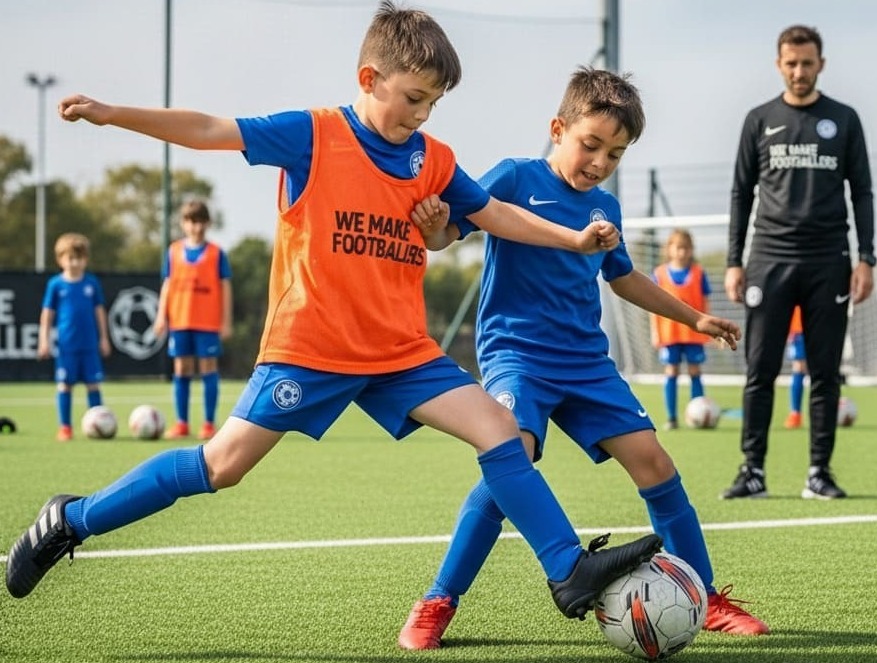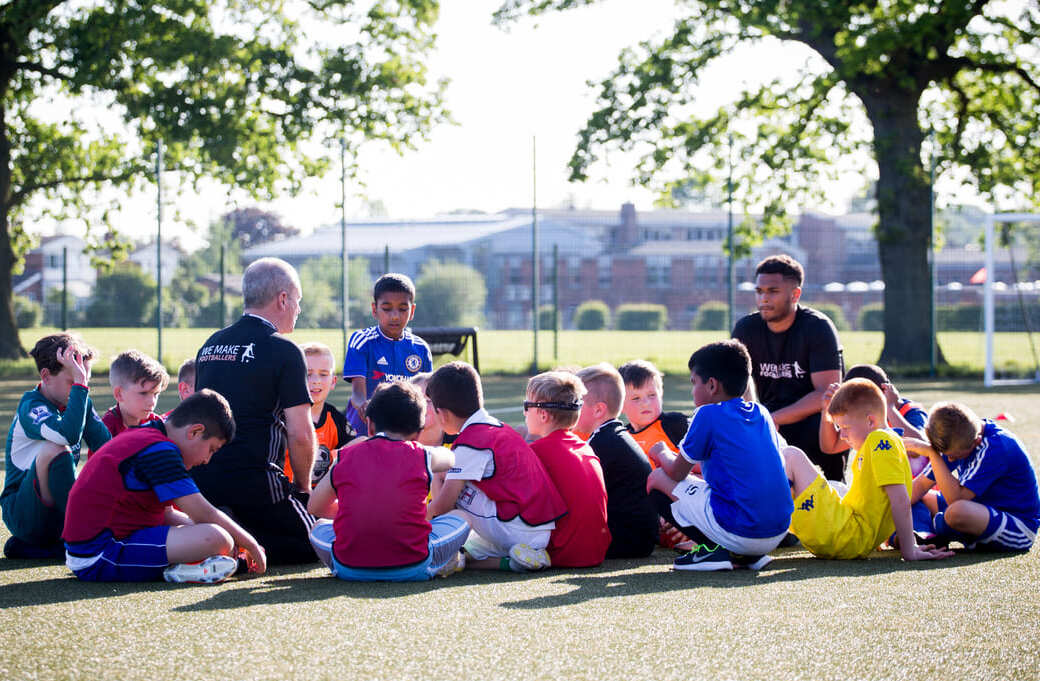The 5 Football Fundamentals: A Beginner’s Guide for those Players New to the Game
Legendary Liverpool manager Bill Shankly once said, “Football is a simple game made complicated by people who should know better.” And he was right. Football is simple once a player new to the game has understood and begun to practice the fundamentals which are essential to the sport.
These fundamentals provide the cornerstone of football. They are the base from which all else flows. From Lionel Messi to Cristiano Ronaldo to Kylian Mbappe, the best players in the world all started out with the fundamentals of football when they were new to the game. The rest developed from there.
At We Make Footballers, football fundamentals feed into everything we do at our weekly football training academies and holiday camps for children aged between 4 and 12. Our mission to improve the ability of every child we teach begins with the fundamentals.
But what are these football fundamentals? And how can players who are new to the game start to develop them?

First touch and ball control
Without ball control and a good first touch, all other football fundamentals become much more difficult or impossible to master. Which makes controlling a football the most fundamental of fundamentals.
If a player is unable to trap, stop or cushion a football when they receive possession, then they will struggle to complete a secondary movement. Lose control of the ball and they cannot embark on a dribble, play a pass or take a touch before shooting.
The most exciting thing about first touch is that it is almost a never-ending process of development and learning. Because the whole body can be used to bring a football under control, there are always new and innovative ways to be found.
Take the foot for example. The inside, outside, laces, underneath and even the heel can be used to control a football. Times that by two as a player masters left and right. Then you have the thigh, the chest, the head, the shoulder (if you can get away with such things in the VAR era).
Low passes fizzed at pace into feet. Longer cross field passes requiring bringing down from the air. Awkward, spinning balls dropping out the sky via a deflection or block. Bouncing balls made difficult to read or predict coming off an uneven pitch surface. There is so much variation in the sort of pass a football player can receive and need to deal with.
Great players like Kevin De Bruyne, Harry Kane, Keira Walsh and Ella Toone are so dangerous because their first touch is reliable in any given situation. Begin to master control of a football and the game becomes that much easier.
Dribbling
When space is tight on a football pitch, dribbling is one of the most effective routes to opening a game up. The good news for those new to the game is that this football fundamental is naturally ingrained in most of us.
Give a football to a very young child and the natural instinct of most (presuming it is not picking it up) is to kick the ball ahead of them and chase after it. Dribbling is honing that inclination, making it more technical and therefore more effective.
Because dribbling tends to come more naturally, it is in some quarters seen as an art rather than science. Can you really teach the way Messi or Lauren James weave around defenders, as if the ball is stuck to their feet with superglue and opponents are mere ghosts?
It is an interesting debate. What coaches can do is improve balance and footwork, which in turn lends itself to more effective dribbling technique.
The ability to change direction quickly bamboozles opponents when a player runs with the football, as does the unpredictability that comes from being able to manipulate the ball with all parts of the foot.
Young players will naturally have their focus drawn into looking down at what is going on at their feet when running with the ball. But once they have developed the basics, observing the ball with their peripheral vision to otherwise look up, scanning for space and possible passes will take their dribbling onto another level.
Passing
Thanks to Pep Guardiola and his Barcelona team who were amongst the greatest club sides to play the game, passing has never been more fundamental to football than it is in the 21st century.
We Make Footballers follow the lead set by Guardiola and his tiki-taka, possession-based style. Keeping the ball successfully before finding the killer pass to create a shooting opportunity is one of the most effective ways to scoring goals and winning matches.
Becoming a good passer is about slow and steady progress. Players new to football start out by learning the basics of accurate passing over short distances. Gradually these become longer and more varied, with switches of play and crosses being introduced to the mix.
Passing of course is about more than just technique. Vision in terms of spotting openings, communication with teammates and decision making in knowing which is the right option when confronted with more than one possibility all combine to create the skillset of the ultimate passer.
Shooting
Shooting is the fundamental above all else that every young player new to football wants to dive in and practice straight away. The game is all about scoring goals after all and unless you shoot, you are not going to score.
Shooting though is not as easy as it seems. You only have to look at the Premier League to realise that. Take Darwin Nunez at Liverpool. At the midway point of the 2023-24 season, Nunez had recorded 15 goals from 37 matches.
And yet he was criticised by plenty of fans and pundits for the number of chances missed rather than the goals scored. Even a striker who cost £85 million and has a strike rate of almost one goal every two games gets told he needs to improve his shooting.
No such pressure exists at We Make Footballers academies. Our practice makes permanent ethos means making mistakes is viewed as all part of the development process. There is no better way for a young football player to learn than by bouncing back from their own errors.
Learning the fundamentals of passing and control first prepares a football newcomer for what is needed when it comes to shooting. Balance, decision making and being able to use different parts of the foot are all key to a successful shot.
Accuracy is valued over power, which comes later. Striking the ball as hard as possible is rendered pointless if it is not on target. Like every other skill in football, good technique matters more than anything else.
There are few better feelings in football than seeing the ball bulge in the back of the net, making successful shooting a fundamental of both the sport itself and the enjoyment the game brings.
Winning back possession
Not too long ago, the heading for our fifth and final football fundamentals for those new to the game would have been tackling. The sport has evolved now for that word to feel a little outdated. It is all about winning back possession.
Tackling of course still plays an important part in winning back possession. A defender or midfielder sliding in to take the ball off an opponent in a professional game can look spectacular and will often draw a roar from the crowd.
But why make a tackle if you do not need to? Paolo Maldini was one of the greatest defenders to ever play the game. He once said, “If I have made a tackle, then I have made a mistake.” The point being that a tackle is usually a last gasp attempt to regain possession.
When the Lionesses won Euro 2022, captain Leah Williamson famously won the ball back more than any other player at the tournament but without making a single tackle according to UEFA’s official statistics.
Williamson displayed perfect reading of the game and impeccable positioning to always be in the right place at the right time. To watch her is to see the beauty of winning back possession – and it was fundamental to England being crowned European champions and inspiring the country.
We Make Footballers and football fundamentals
Our We Make Footballers academies are for children aged between 4 and 12 of all abilities. We focus on a different football fundamental each week with a strong emphasis on honing technical ability. Sessions include over 80 percent ball rolling time and over 500 touches of the ball.
With small groups of no more than 10 children per coach, our football training is focused and tailored to the needs and ability levels of each individual player. Skills are then mastered through our practice makes permanent ethos in a fun and safe environment led by FA qualified coaches.
The We Make Footballers approach to instilling football fundamentals into those new to the game first and developing talent from there via 1v1 training, game scenarios and other innovative coaching mechanisms has seen over 200 graduates of our academies sign for professional clubs and football academies.
To find your nearest academy and sign up for a free first session, please visit the We Make Footballers website.



